Iomega unveils Boxee-based media server
Jan 4, 2011 — by Eric Brown — from the LinuxDevices Archive — 20 viewsEMC subsidiary Iomega announced a Linux- and Intel Atom-based “Iomega TV with Boxee” media server with network attached storage (NAS) capabilities and Boxee's IPTV software stack. The company also announced a Home Media Network Hard Drive Cloud Edition that works with a newly announced Iomega Personal Cloud service, and tipped an Iomega ScreenPlay DX HD Media Player.
The Iomega TV with Boxee is the latest in a long line of NAS devices such as last year's iConnect Wireless Data Station, all running on Iomega's Linux-based EMC LifeLine operating system. The difference is that this device also offers Boxee's cross-platform IPTV stack, and is designed to hook up to a TV as well as the home LAN.
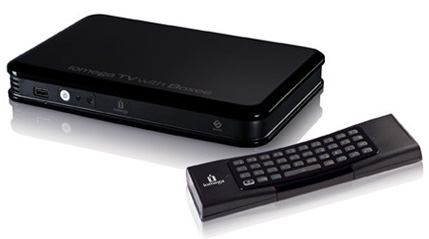
Iomega TV with Boxee
Iomega TV with Boxee
Iomega TV with Boxee lets users view thousands of TV shows and movies on their schedule, as well as use over 150 apps, says 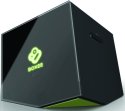 Iomega. The device runs LifeLine and the Boxee stack on Intel's TV-oriented Atom CE4100 chipset.
Iomega. The device runs LifeLine and the Boxee stack on Intel's TV-oriented Atom CE4100 chipset.
The CE4100 appears on all the Google TV devices announced to date, including the Sony Internet TVs and Logitech Revue STB. In September, D-Link announced it had switched its own Boxee-infused STB/media server — the Boxee Box (pictured at right) — to the CE4100, as well.
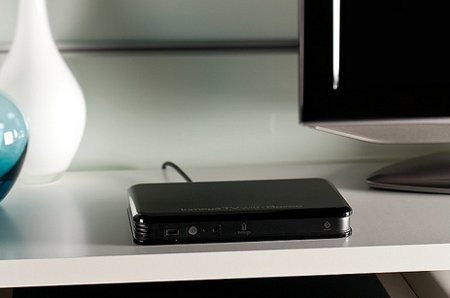
Iomega TV with Boxee in its natural setting
The device is equipped with 802.11n Wi-Fi, dual USB ports, HDMI or composite video ports, and optical audio outputs, says the company. Also supplied is a QWERTY remote control.
Boxee's social-networking-focused Boxee stack is based on the XMBC Media Center source project, and is available for Mac, Linux, and Windows desktops, among other devices. Boxee lets users browse for TV clips from sources like CBS, NBC, Comedy Central, HGTV, the Cartoon Network, and thousands of movies from VUDU. Other sources include Crackle, Pandora, mainstream broadcast media, and cable outlets, says Iomega.

Iomega TV with Boxee, rear view
(Click to enlarge)
In addition to Boxee, the Iomega TV with Boxee offers the Linux-based LifeLine NAS OS, offering a suite of storage, security, and media sharing applications. LifeLine supports Universal Plug and Play (UPnP) and Digital Living Network Alliance (DLNA) standards, enabling users to save, store, and play back music, photos, videos, and other digital content.
LifeLine is also said to offer an integrated iTunes servers, and other media servers including a Torrent download manager for managing peer-to-peer file transfers. In addition, users can remotely access and administer the device through a personalized web address, says the company.
LifeLine software lets users stream media from network-attached Windows-, Mac- and Linux-based computers, as well as other compatible network devices, says the company. It supports codecs and file formats including H.264, WMV, and MKV.
Stated Avner Ronen, Boxee CEO and co-founder, "As we take Boxee's platform into a variety of living-room devices, Iomega TV with Boxee has a unique appeal for many of our users as an all-in-one home for entertainment and storage."
Home Media Network Hard Drive Cloud Edition
Also today, Iomega announced a new network HDD, as well as an associated Iomega Personal Cloud service that works with the drive. The cloud service is also said to work with the Iomega TV with Boxee and other new Iomega NAS devices.
Available later this month in 1TB and 2TB capacities, the single-drive Home Media Network Hard Drive Cloud Edition updates an earlier model, bridging the gap between HDDs and full-fledged NAS devices. The drive improves upon Iomega's earlier networked HDDs with improved performance and easier menus and settings, says Iomega.
Processor or memory details are not listed, but the device is said to provide a gigabit Ethernet port, two USB 2.0 ports, and a Quik Transfer button.
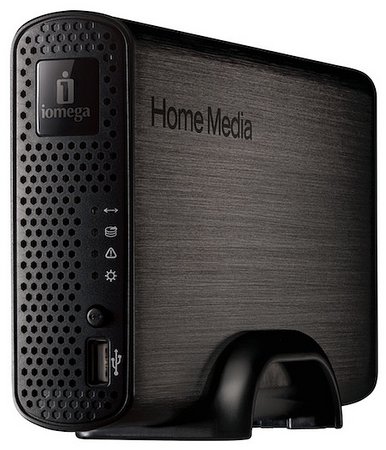
Home Media Network Hard Drive Cloud Edition
Equipped with the same Linux-based LifeLine software as the Boxee product, the Home Media Network Hard Drive Cloud Edition "makes it easy for home users and small businesses to share work files, photo slideshows, music libraries and other files with co-workers, friends and families anywhere in the world," says Iomega.
In addition to other LifeLine media server, remote access, and security features, the drive provides device-to-device replication for data protection. This allows users to define a job to copy and synchronize files to and from the connected USB drives or any other shared storage on the network.
With the free Iomega Personal Cloud service, this replication capability extends to online cloud storage, letting Iomega users remotely backup onsite data to an alternate location. Cloud users can invite up to 250 members (devices) into their own personal cloud, offering file sharing according to different user-specified permissions.
Users can also sync files directly as if they were on a LAN, says the company. No storage limits were listed.
Iomega ScreenPlay DX HD Media Player
Finally, Iomega posted a teaser page for an Iomega ScreenPlay DX HD Media Player, with a "coming soon" banner. In addition, Slashgear says a similar Iomega ScreenPlay TV Link DX HD Media Player is also coming. Most likely, both devices also run the LifeLine OS.
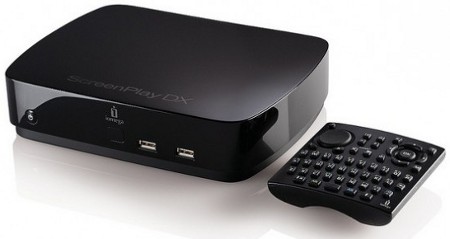
Iomega ScreenPlay DX HD Media Player
Audio and video format support includes H.264, WMV, RMVB, MPEG-1/2/4 (part 2, ASP), DivX, DivX Plus HD (MKV), XviD, AVI (Xvid, AVC, MPEG1/2/4), ISO, VOB, MP4, MOV, and MKV, says Iomega.
According to the Slashgear story, both the ScreenPlay DX HD and the TV Link version also supply HDMI and optical digital out ports, as well as multiple USB 2.0 ports. The site has no other info on the TV Link version, but speculates that it's a diskless version.
Availability
The new Iomega TV with Boxee and the new Iomega TV with Boxee + Storage products are expected to be available worldwide in February. Iomega TV with Boxee costs $230 without storage. The Iomega TV with Boxee + 1TB Storage is $300, and the Iomega TV with Boxee + 2TB Storage is $350, says Iomega.
J&R Music and Computer World will be selling the Iomega TV with Boxee later this quarter, says the company. More information and shipment notification sign-up may be found at Iomega's Iomega TV with Boxee page. Iomega is unveiling the new Iomega TV with Boxee product line Jan. 6-9 at the Consumer Electronics Show in Las Vegas at their South Hall 3 booth (# 31553).
The Iomega Home Media Network Hard Drive Cloud Edition will be available worldwide later this month in two capacities: a 1TB model for $170 and a 2TB model for $230. More information on Iomega's new HDD may be found in Iomega's Home Media Network Hard Drive Cloud Edition announcement.
The teaser page for the new ScreenPlay media server may be found at the Iomega ScreenPlay DX HD Media Player page, and the Slashgear story should be here.
This article was originally published on LinuxDevices.com and has been donated to the open source community by QuinStreet Inc. Please visit LinuxToday.com for up-to-date news and articles about Linux and open source.